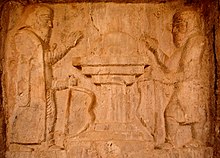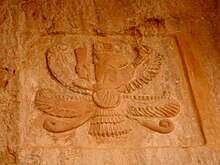The rock tombs of Qyzqapan[1] or Qizqapan (Kurdish: ئهشكهوتی قزقاپان, romanized: Ashkawt-i Qizqapan), is a rock-cut tomb lying near the Palaeolithic cave of Zarzi in Iraqi Kurdistan.[2]


Story
editAshkawt (also spelled Ishkewrt ئەشكەوت) means cave in Sorani Kurdish. Qizqapan means "rapist" or "ravisher" in Turkish. The cave is also known as the cave of the abducted girl (Kurdish: ئەشكەوتی كچه دزراوەكه).[2]
History
editThe rock-cut tomb has three burial chambers, each with a hewn grave in the left corner, all accessible from the central chamber.[3][2] The entrance into the tomb lies approximately 8 meters above the ground level.
Different dates from the Medes, Achaemenid, Seleucid, and Parthian periods have been proposed for the construction of the tomb.[4][5] The general belief of scientists is that the tomb was built by the Medes people [6] [7]
The symbols of the tomb refers to Mithraism,[8] with Mithra being the supreme deity of Medes.[2] Some scholars such as Igor Diakonov believe that the tomb was built for the Median ruler Huvaxshatra or Cyaxares.[9] if the Qyzqapan tomb is a royal one (which is very likely) the warrior is none other than Cyaxares.[10]
References
edit- ^ Gershevitch, Ilya (1985). The Cambridge History of Iran - Vol2 - The Median and Achaemenian Periods. Cambridge University Press.
- ^ a b c d Shukir, Osama (2018). "The Rock-Cut Tombs of Qizqapan, Iraqi Kurdistan".
- ^ "Qyzqapan Tomb".
- ^ "QIZQAPAN: A ROCK-CUT TOMB FROM THE MEDIAN, ACHAEMENID, SELEUCID OR PARTHIAN PERIOD?".
- ^ name=":0">Shukir, Osama (2018). "The Rock-Cut Tombs of Qizqapan, Iraqi Kurdistan".
- ^ Gershevitch, Ilya (1985). The Cambridge History of Iran - Vol2 - The Median and Achaemenian Periods. Cambridge University Press.
- ^ Diakonoff, Igor. "Media".
- ^ "Qizqapan".
- ^ Diakonoff, Igor. "Media".
- ^ Gershevitch, Ilya (1985). The Cambridge History of Iran - Vol2 - The Median and Achaemenian Periods. Cambridge University Press.